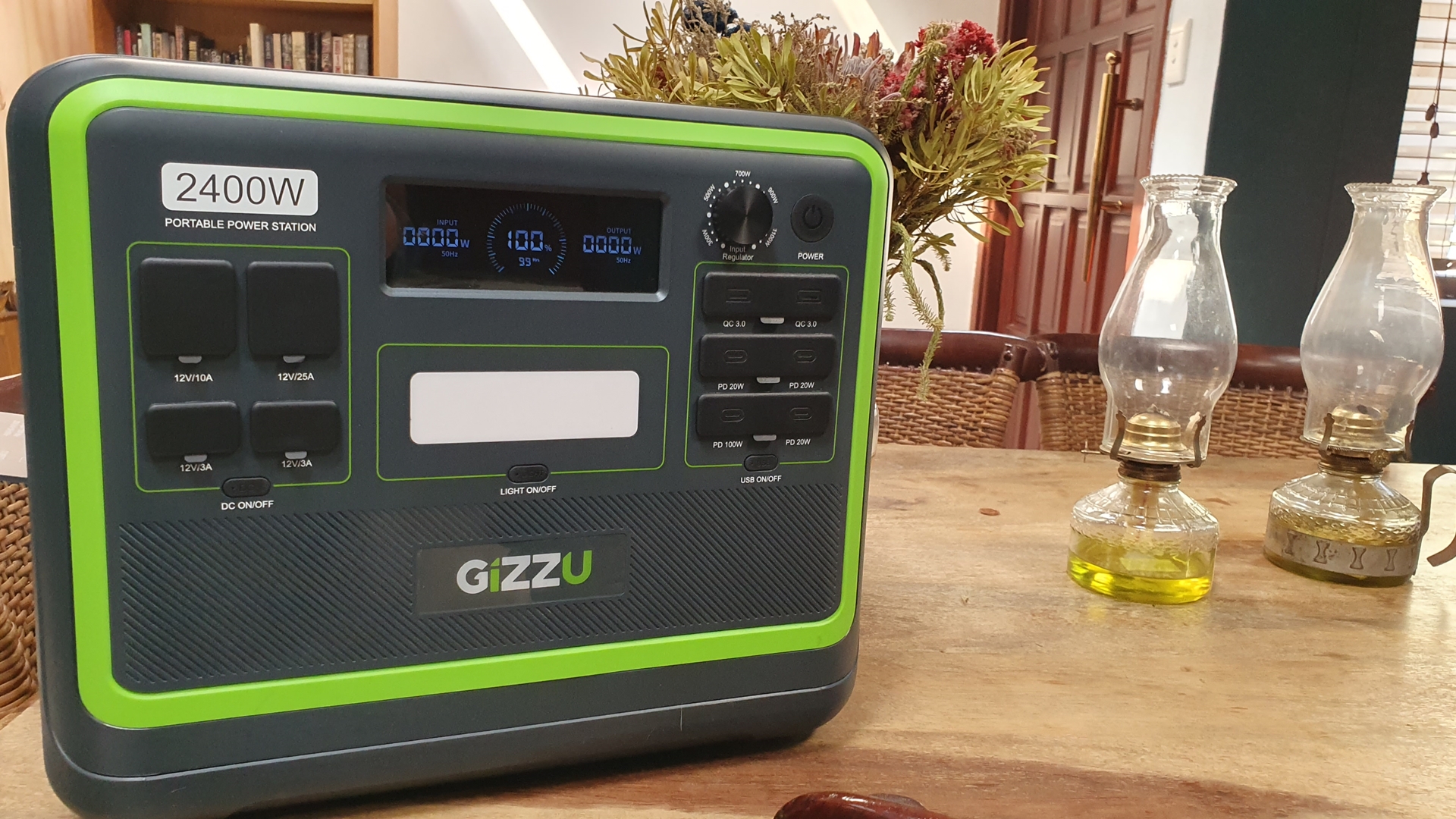Having reviewed a few power stations from EcoFlow that contain Lithium-iron phosphate (LiFePO4) battery technology, we were intrigued when Gizzu offered up its latest 2 048Wh behemoth, the Hero Pro, for review.
For one, the capacity is immense, doubling the capacity available in our favourite product so far, the EcoFlow Delta 2. With a price of R24 999 the Gizzu is stepping up to EcoFlow and laying down a challenge.
Has Gizzu managed to compete?
Absolutely and what follows is why we recommend this product wholeheartedly.
Biggest of the bunch
Weighing in at 22.5kg, and measuring 39.2 x 27.9 x 32.3cm, the Hero Pro is a large piece of kit. The unit is decked out in a grey and green colourway that at first we found a bit jarring, but it’s grown on us over time. There is a 1W light on the front of the unit, as well as a bevy of DC outputs including:
- 3x Type-C 20W PD Port (5V-3A, 9V-2.22A, 12V/1.67A),
- 1x Type-C 100W PD Port (5V/9V/12V/15V-3A, 20V/5A),
- 2x USB-A 18W QuickCharge 3.0 Port,
- 1x Car Socket Port (12V/10A),
- 2x DC5521 Ports (12V/3A),
- 1x XT60 Port (12V/25A).

For AC power there are two, three-prong (South African standard) 220-240V 50Hz outputs that have a rated output of 2 400W. The Hero Pro can be charged using an AC plug or using solar panels. You can also, in a pinch, charge the power station using your car. There’s even a convenient storage compartment on the top of the unit to keep additional cables.

As for noise, the Hero Pro is near silent with the fans only really ramping up when on battery power and the draw gets high. For most things though you’ll hardly hear the fans.
Up front, alongside the power button, you will find an adjustable regulator that lets you select how much power the Hero Pro draws from the wall. This is a must-have feature in a portable power station and we’re very happy to see that there is a physical dial on the unit rather than having to make these changes via an app as EcoFlow chose.
In fact, there is no app that pairs with the Hero Pro at all making this a great power station for the less tech-savvy. The dial allows you to select a 300W, 500W, 700W, 900W, and 1 100W input.

As there is no app, all the information you need can be found on the main display up front. This information includes the input power (and what input is being used), output power, battery charge capacity, and how long the battery will run until it needs to be charged up.
Charging times will vary depending on how much power you used and how much power you’re drawing. From 16 percent capacity charging at the maximum input draw of 1 100W, the Gizzu Hero Pro took 90 minutes to fully charge. Helpfully, the display gives you an estimate of how long the unit will take to fully recharge.
What did it power?
An air fryer. Yes, this behemoth of a power station managed to cook my dinner during a bought of Stage 6 loadshedding and while it drew an insurmountable amount of power, it worked. The Hero Pro reported that at 1500W draw, it would last little over an hour. What’s impressive is that so long as your total draw doesn’t exceed 2400W, the Hero Pro will keep you running for a while.
The length of time is highly dependent on what you’ve connected to the power station. For example, a desktop gaming PC, two Full HD displays, a notebook, a router, and two low-wattage lights stayed on for 11 hours before the Hero Pro needed to be juiced up.

For a small home office, 2 048Wh is ample. With power grids suffering under the strain of higher levels of loadshedding, that capacity is incredibly helpful in the event of further outages after the power is meant to come back. Perhaps most impressive is the 10ms switch-over time the Gizzu Hero Pro boasts. It makes for a seamless transition from mains to battery power.
While it is fast, it’s not instant so if you need backup power with an instant switch-over take note of the Gizzu’s limitation here.

Just in case, the unit features Short-Circuit, Over-Current, Over Voltage, and Under Voltage protections.
The number of ways that the power station could be recharged gave us peace of mind that even if the unit ran flat, we had ways to continue having access to power in some form.
Conclusion
Reviewing a piece of technology relies on being able to measure certain things, interpret those measurements, and state objective facts. However, the Gizzu Hero Pro also gave us peace of mind which isn’t something we can easily quantify and convey to you.
The idea that even in Stage 6 loadshedding I could power my PC and play games with my friends or even cook an entire meal in a pinch using an air fryer and a gas cooker made power cuts a lot more bearable.
Objectively though, the Gizzu Hero Pro has ample capacity for small offices and families that want to watch TV, play games, or even cook a meal. What’s more is that if you eventually decide to install solar power, the Hero Pro can function as a battery store.
The output is impressive, the design is intuitive and while it is heavy, we understand this is due to the massive batteries the unit houses. There is almost nothing to fault Gizzu on here. The Hero Pro works as advertised and should – given the longer lifespan of LiFePO4 batteries – last a good few years under loadshedding.
If you’re sick of sitting in the dark, consider the Gizzu Hero Pro, we’re sure you’ll love it as much as we did.
FINAL SCORE: 10 OUT OF 10.

